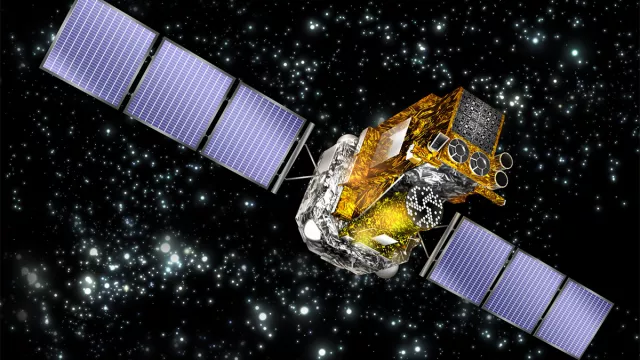The Integral satellite (INTErnational Gamma-Ray Astrophysics Laboratory), developed by ESA in partnership with the United States and Russia, was launched in 2002 on a mission to observe cosmic gamma rays and study the properties of celestial objects like black holes and supernovae.
Key information
| Mission | Gamma-ray astronomy |
|---|---|
| Domain | Science |
| Launch date | 17 October 2002 |
| Partners | ESA, IRAP (ex-CESR), CEA, IAP, Universidad de Valencia Edificio de Investigacion, Max Planck Institute for Extraterrestrial Physics, IAPS Rome (ex-IAS Frascati), Catholic University of Louvain, Space Sciences Laboratory, University of California San Diego, NASA, IASF-Bologna (ex-ITESRE), IASF-Palermo (ex-IFCAI), University of Tübingen, University of Bergen, SRC Warsaw, Nicolas Copernicus Astronomical Center, Warsaw |
| Where | 72-hour orbit at an altitude varying between 9,000 and 153,000 km |
| Lifetime | Initially scheduled to last 10 years, extended to 31 December 2024 |
| Status | In operation |
Key figures
- 4,000 kg: satellite mass
- 4 scientific instruments
- 3 keV to 10 MeV: energy range of observable gamma rays
- 5 x 2 x 3 m: satellite dimensions
Key milestones
- End 2022: ESA extends mission to December 2024
- End 2020: ESA extends mission to December 2022
- November 2018: ESA extends mission to December 2020
- November 2016: ESA extends mission to December 2018
- 19 June 2013: ESA extends mission to December 2016
- 19 November 2010: ESA extends mission to December 2014
- 2 October 2009: ESA extends mission to December 2012
- 27 July 2006: ESA extends mission to December 2010
- 17 October 2002: Integral launched by Proton
- 9 May 2001: Flight model of SPI instrument delivered to Alenia Spazio, Italy
- June 1993: ESA selects Integral for its Horizon 2000 science programme
Project in brief
17 October 2002, the Integral satellite departed Earth on its mission to analyse gamma rays, electromagnetic waves 100,000 times more energetic than visible light that are emitted notably by black holes and supernovae (a ‘supernova’ is an exploding star that generates an extraordinarily bright and sudden emission of light). Using the data Integral has collected, astrophysicists hope not only to gain new insights into the cosmic phenomena that generate gamma rays, but also to map emission sources of this radiation in the universe. For this purpose, Integral has four instruments, one of which is the SPI spectrometer developed by CNES as prime contractor.
The Integral mission led by ESA is an international effort associating several European nations (Belgium, Czech Republic, France, Germany, Italy, Poland, Spain and the United Kingdom), the United States and Russia. Initially scheduled to last 10 years, the mission has been extended to end 2024.
Since its launch, Integral has made significant contributions to astrophysics research into gamma-ray bursts, the electron-positron annihilation line, nucleosynthesis and the discovery of new sources, offering a new and detailed perspective of the gamma-ray universe.
CNES’s role
The Integral satellite’s SPI spectrometer was developed by CNES as prime contractor. It was thus in charge of mechanical and thermal design, software and electrical design, as well as establishing overall design specifications, subassembly requirements, internal and external interfaces, and the product assurance plan. It was also responsible for integration work at its Toulouse Space Centre and for defining tests and operations at Intespace.
CNES was in charge of the spectrometer design and tasked fabrication of parts of the instrument (including the satellite/spectrometer interface structure, thermal control, the cryostat, flight software and the electrical harness).
Four different development models were built, each with different objectives. Two were used to test and qualify interfaces with the satellite, but not to obtain data on the instrument’s inner workings. This aspect was clarified using two qualification models: the Structural and Thermal Model (STM) and the Engineering Model (EM). The Flight Model (FM) was subjected to additional qualification tests and nominal acceptance tests. All five models were integrated by a CNES team in the clean room at the Toulouse Space Centre.
Contacts
Astronomy & Astrophysics subject matter expert
Philippe Laudet
E-mail: philippe.laudet at cnes.fr


